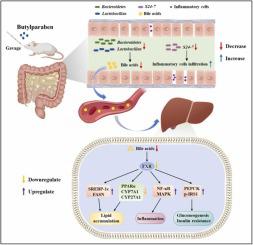当前位置:
X-MOL 学术
›
J. Hazard. Mater.
›
论文详情
Our official English website, www.x-mol.net, welcomes your
feedback! (Note: you will need to create a separate account there.)
Butylparaben induces glycolipid metabolic disorders in mice via disruption of gut microbiota and FXR signaling
Journal of Hazardous Materials ( IF 12.2 ) Pub Date : 2024-06-05 , DOI: 10.1016/j.jhazmat.2024.134821 Haining Du 1 , Lili Cui 2 , Xinyi Zhao 3 , Ziteng Yu 3 , Tianyue He 3 , Boya Zhang 3 , Xingpei Fan 3 , Meimei Zhao 3 , Ruijiao Zhu 3 , Ziyi Zhang 3 , Mengcong Li 3 , Jiaxin Li 3 , Yuri Oh 4 , Ning Gu 1
Journal of Hazardous Materials ( IF 12.2 ) Pub Date : 2024-06-05 , DOI: 10.1016/j.jhazmat.2024.134821 Haining Du 1 , Lili Cui 2 , Xinyi Zhao 3 , Ziteng Yu 3 , Tianyue He 3 , Boya Zhang 3 , Xingpei Fan 3 , Meimei Zhao 3 , Ruijiao Zhu 3 , Ziyi Zhang 3 , Mengcong Li 3 , Jiaxin Li 3 , Yuri Oh 4 , Ning Gu 1
Affiliation

|
Butylparaben, a common preservative, is widely used in food, pharmaceuticals and personal care products. Epidemiological studies have revealed the close relationship between butylparaben and diabetes; however the mechanisms of action remain unclear. In this study, we administered butylparaben orally to mice and observed that exposure to butylparaben induced glucose intolerance and hyperlipidemia. RNA sequencing results demonstrated that the enrichment of differentially expressed genes was associated with lipid metabolism, bile acid metabolism, and inflammatory response. Western blot results further validated that butylparaben promoted hepatic lipogenesis, inflammation, gluconeogenesis, and insulin resistance through the inhibition of the farnesoid X receptor (FXR) pathway. The FXR agonists alleviated the butylparaben-induced metabolic disorders. Moreover, 16 S rRNA sequencing showed that butylparaben reduced the abundance of , and , and elevated the / ratio. The gut microbiota dysbiosis caused by butylparaben led to decreased bile acids (BAs) production and increased inflammatory response, which further induced hepatic glycolipid metabolic disorders. Our results also demonstrated that probiotics attenuated butylparaben-induced disturbances of the gut microbiota and hepatic metabolism. Taken collectively, the findings reveal that butylparaben induced gut microbiota dysbiosis and decreased BAs production, which further inhibited FXR signaling, ultimately contributing to glycolipid metabolic disorders in the liver.
中文翻译:

对羟基苯甲酸丁酯通过破坏肠道微生物群和 FXR 信号传导诱导小鼠糖脂代谢紊乱
对羟基苯甲酸丁酯是一种常见的防腐剂,广泛应用于食品、药品和个人护理产品中。流行病学研究揭示了尼泊金丁酯与糖尿病的密切关系;然而作用机制仍不清楚。在这项研究中,我们给小鼠口服对羟基苯甲酸丁酯,观察到接触对羟基苯甲酸丁酯会引起葡萄糖不耐受和高脂血症。 RNA测序结果表明差异表达基因的富集与脂质代谢、胆汁酸代谢和炎症反应相关。蛋白质印迹结果进一步证实,尼泊金丁酯通过抑制法尼醇 X 受体 (FXR) 途径,促进肝脏脂肪生成、炎症、糖异生和胰岛素抵抗。 FXR 激动剂减轻了对羟基苯甲酸丁酯引起的代谢紊乱。此外,16 S rRNA 测序表明,对羟基苯甲酸丁酯降低了 、 和 的丰度,并提高了 / 的比率。对羟基苯甲酸丁酯引起的肠道菌群失调导致胆汁酸(BA)产生减少和炎症反应增加,进一步诱发肝脏糖脂代谢紊乱。我们的结果还表明,益生菌可以减轻对羟基苯甲酸丁酯引起的肠道微生物群和肝脏代谢紊乱。总的来说,研究结果表明,对羟基苯甲酸丁酯会引起肠道微生物群失调并减少 BA 的产生,从而进一步抑制 FXR 信号传导,最终导致肝脏中的糖脂代谢紊乱。
更新日期:2024-06-05
中文翻译:

对羟基苯甲酸丁酯通过破坏肠道微生物群和 FXR 信号传导诱导小鼠糖脂代谢紊乱
对羟基苯甲酸丁酯是一种常见的防腐剂,广泛应用于食品、药品和个人护理产品中。流行病学研究揭示了尼泊金丁酯与糖尿病的密切关系;然而作用机制仍不清楚。在这项研究中,我们给小鼠口服对羟基苯甲酸丁酯,观察到接触对羟基苯甲酸丁酯会引起葡萄糖不耐受和高脂血症。 RNA测序结果表明差异表达基因的富集与脂质代谢、胆汁酸代谢和炎症反应相关。蛋白质印迹结果进一步证实,尼泊金丁酯通过抑制法尼醇 X 受体 (FXR) 途径,促进肝脏脂肪生成、炎症、糖异生和胰岛素抵抗。 FXR 激动剂减轻了对羟基苯甲酸丁酯引起的代谢紊乱。此外,16 S rRNA 测序表明,对羟基苯甲酸丁酯降低了 、 和 的丰度,并提高了 / 的比率。对羟基苯甲酸丁酯引起的肠道菌群失调导致胆汁酸(BA)产生减少和炎症反应增加,进一步诱发肝脏糖脂代谢紊乱。我们的结果还表明,益生菌可以减轻对羟基苯甲酸丁酯引起的肠道微生物群和肝脏代谢紊乱。总的来说,研究结果表明,对羟基苯甲酸丁酯会引起肠道微生物群失调并减少 BA 的产生,从而进一步抑制 FXR 信号传导,最终导致肝脏中的糖脂代谢紊乱。


















































 京公网安备 11010802027423号
京公网安备 11010802027423号